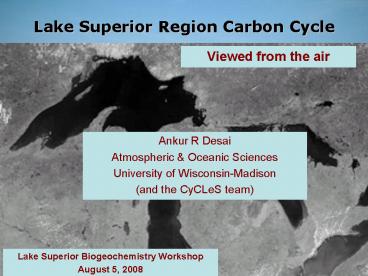Viewed from the air - PowerPoint PPT Presentation
1 / 52
Title:
Viewed from the air
Description:
Adapt the MIT-GCM ocean model to simulate physical and biogeochemical ... 3D sonic anemometer. Open or closed path gas analyzer. 5--20 Hz temporal resolution ... – PowerPoint PPT presentation
Number of Views:25
Avg rating:3.0/5.0
Title: Viewed from the air
1
Lake Superior Region Carbon Cycle
- Viewed from the air
Ankur R Desai Atmospheric Oceanic
Sciences University of Wisconsin-Madison (and the
CyCLeS team)
Lake Superior Biogeochemistry Workshop August 5,
2008
2
Whats in the airwaves?
- Lakes, lands, carbon
- The atmospheric tracer view
- An eddy flux view
- Lake Superior micrometerology
3
Lakes, Land, Carbon
4
The big picture
- Sarmiento and Gruber, 2002, Physics Today
5
Slightly smaller picture
- Cardille et al. (2007)
6
Real Numbers Are Complicated
- Atmos. flux 3-12 Tg yr-1 - 35-140 gC m-2 yr-1
7
An Oceanic Lake
- CyCLeS Cycling of Carbon in Lake Superior
- Adapt the MIT-GCM ocean model to simulate
physical and biogeochemical environment of Lake
Superior - Physical model of temperature, circulation
- Mostly implemented
- Biogeochemical model of trace nutrients and
air-sea exchange - In progress
8
Interesting Questions
- How do magnitudes of lake and land flux compare
and what does it imply for regional carbon
budgets? (NACP, SOCCR) - Are interannual variations in lake and land CO2
surface-atmosphere flux related and if so, due to
what environmental forcing? - Can we see and constrain lake (and land) flux
from regional atmospheric CO2 observations? - What are impacts on atmospheric forcing
(temperature, stable layer depth, CO2) on lake
biogeochemistry?
9
The Atmospheric Tracer View
10
Global CO2
- NOAA/ESRL/GMD/CCGG
11
Global Experiment
- Marland et al., DOE/CDIAC
12
The Inverse Idea
13
The Inverse Idea
- Courtesy S. Denning, CSU
14
The Inverse Idea
- Peters et al (2007) PNAS
15
Inversion and a Very Big Tower
- WLEF-TV (PBS)
- Park Falls, WI
- 447-m tall
- 6 levels CO2
- 11 to 396 m
- 3 levels CO2 flux
- 30,122,396 m
- Mixed landscape
- Representative?
- Running 1995-
16
A 1-point Inversion
- CO2 Air flowing over lake gt CO2 over land
17
Air and Lake CO2 Comparison
- Simple boundary layer budget tracer study
suggests summer 2007 efflux 4-14 gC m-2 d-1 - extrapolated to 30-140 gC m-2 yr-1
- Analysis requires modeling of stable marine
boundary layer - Larger than traditional air-sea pCO2 exchange
calculation - Requires significant respiration in water column
- Urban et al. (in press)
18
The Boundary Layer Problem
- Courtesy of S. Spak, UW
19
Getting More Sophisticated
- Courtesy M. Uliasz, CSU
- Tracer transport modeled influence function
August 2003 at WLEF
entire domain
water
land
20
Great Lakes Influence at WLEF
- Land 85.4
- Lake Superior 9.5
- Lake Michigan 1.8
- Other water 3.1
21
The Potential
- Potential exists for constraining flux and
interannual var. with local observations of CO2
1996
2003
22
An Eddy Flux View
23
Eddies?
- Tracers in boundary layer primarily transported
by turbulence - Ensemble average turbulent equations of motion
and tracer concentration provide information
about the effect of random, chaotic turbulence on
the evolution of mean tracer profiles with time - In a quasi-steady, homogenous surface layer, we
can simplify this equation to infer the surface
flux of a tracer
24
Eddies!
25
The Maths
- Some simplifications made
Storage
Turbulent flux
- Equipment
- 3D sonic anemometer
- Open or closed path gas analyzer
- 5--20 Hz temporal resolution
- Multiple level CO2 profiler
26
The Data
27
The Data Pt. 2
28
The Data Pt. 3
29
Much Data
30
A CHEAS-y Lake
31
Scale This!
32
Some Observations
Desai et al, 2008, Ag For Met
33
The 6x6 km View
34
More Observations
35
Land History
36
Land History
- Have to account for age structure too
37
All The ChEAS Flux Data
38
Magically Scaled
39
The Bottom-Up Flux
40
Evaluation
- Top-down vs Bottom-up
41
Evaluation
42
Land
- 1989-2006 average
43
Lake?
44
Lake and Land
45
Lake Superior Micrometeorology
46
Better Forcing?
- Many observations are sparse
47
Better CO2
48
Coherent Interannual Variability
49
Lake Interannual Variability
- Annual avg. dissolved organic carbon (DOC)
50
More measurements
- CO2 over Lake Superior
- Continuous CO2 eddy covariance on the lake
- Better models of stability over lakes
- Spatial atmospheric met data
- Temp, wind, precip?, shortwave radiation
51
Conclusions
- On annual and decadal timescales, Lake Superior
is possibly a source of CO2 to the atmosphere - This source could be on the same order of
magnitude as the terrestrial regional sink - Regional carbon budgets have to take lakes into
account - We can estimate this flux from a number of
techniques - Lake models may need to worry about
spatiotemporal variability in atmospheric forcing - Models to tie land carbon flows into lake carbon
can be useful for Lake Superior - Model-data fusion/optimization/assimilation
techniques should be explored
52
Thanks
- Desai lab and friends Ben Sulman, Jonathan Thom,
Shelley Knuth, Scott Spak - ChEAS collaborators, esp. Bruce Cook, Paul
Bolstad, Ken Davis, D. Scott Mackay, Nic
Saliendra, Sudeep Samanta - CyCLeS team Galen McKinley, Noel Urban, Chin Wu,
Nazan Atilla, Val Bennington - Funding DOE NICCR, NSF, USDA, NSF/NCAR, NASA,
NOAA, under auspices of the North American Carbon
Program (NACP) - Come visit us
- AOSS 1549, desai_at_aos.wisc.edu, 265-9201
- More info
- http//flux.aos.wisc.edu

